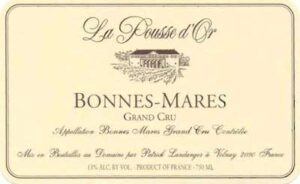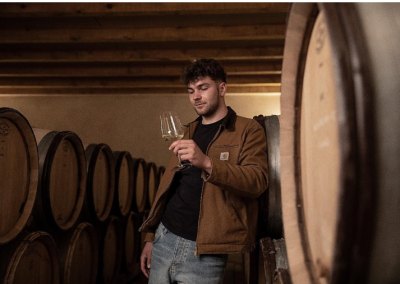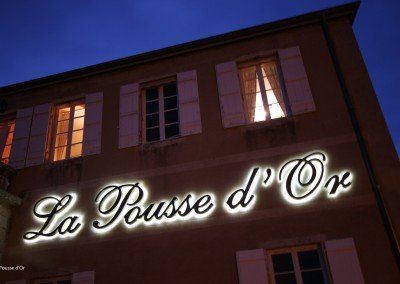Domaine de la Pousse d'Or
Volnay | Côte de Beaune | BurgundyDomaine de la Pousse d’Or for decades has been the collector’s choice for expressive wines from Burgundy’s most hallowed terroirs, and is unquestionably one of the Burgundian elite. Not every estate can claim the king of France as a previous vineyard owner; fewer still can count six grand crus and three monopole vineyards under one roof.
Every winter for years we’ve visited the Landanger family’s stately château in Volnay to sample their new vintage. The moment you step into the estate’s underground caves you are transported to another century. The worn, warped brick floor clearly has weathered generations of winemakers treading from barrel to barrel; vaulted ceilings overhead feel more cathedral than wine cellar.
Originally called La Bousse d’Or (Bousse, in old French, means earth; thus, “golden earth”), the domaine in the late 1800s was part of a much larger estate that included two well-known vineyards: Romanée-Conti and Clos de Tart. The name ‘La Bousse d’Or’ hasn’t completely disappeared; it is carried by a walled vineyard in Volnay and is one of the estate’s monopoles—a vineyard with a single owner—that from the mid-fifteenth century onward, belonged to the king of France. (After the revolution, granted, things changed a bit.)
Entrepreneur Patrick Landanger purchased Pousse d’Or in 1997, at a point when the estate seemed to have most of its glory days behind it. Patrick poured endless energy (and a good amount of investment) into the estate, acquiring new vineyards as well as reinventing how the estate made its wines, from reorganizing the cellar to work completely via gravity to even inventing his own “ouilleurs,” or airlocks for barrels that allow a winemaker to also top up a barrel easily.
Sadly Patrick Landanger passed away in 2023 after a long illness. His son, Benoît Landanger, now runs the estate—and is as much a talented, passionate visionary as was his father. Pousse d’Or remains in very good hands. Indeed, this dynamic estate has never been content to rest on its historic laurels. The family has gone to great lengths to ensure that the winery lacks for nothing when it comes to crafting quality Burgundy. And having farmed organically from the start, the estate since 2014 has worked the fields biodynamically, another feather in its quality cap.
When vines begin to sprout early buds in the spring, the French say, “Ça pousse.” Pousse d’Or Burgundy captures this sort of urgent energy, this desire to spring forth and dazzle. Benoît Landanger crafts his wines as naturally as possible; juice and wine are moved via gravity, and are bottled unfined and unfiltered in sync with the lunar calendar. Aromas are bold, tending toward black fruits and spice; the palate is textured, silky, always very long. These bottles are gorgeous right out of the gate and only get better, often for decades.
FARMING & WINEMAKING
Pousse d’Or has three premier cru monopoles, or exclusively estate-owned vineyards, in Volnay: ‘Clos de la Bousse d’Or,’ ‘Clos des Soixante (60)-Ouvrées’ and ‘Clos d’Audignac.’
Pousse’s attention to detail and dedication to sustainable viticulture is serious. For years the estate cared for its vines according to organic principles; since 2012, Pousse has incorporated biodynamic practices across all its holdings. As of 2018, the estate has been certified biodynamic per Demeter, a standards body.
Grapes as a rule are harvested and sorted by hand, and bunches are destemmed and fermented on indigenous yeasts in temperature-controlled tanks. Wines are aged 18 months in French oak barrels, with between 30 to 50 percent new wood, depending on the cru.
In recent vintages, Benoit Landanger has been aging some wines in terracotta amphora. Very little sulfites are added at any point during the winemaking process. All wines are moved and then bottled by gravity, and are unfined and unfiltered according to the lunar calendar.
Puligny-Montrachet 1er Cru ‘Le Cailleret’
‘Cailleret’ offers a depth of flavor and minerality that reminds of its neighbor, Montrachet. Pousse’s plot is bordered by stone walls, and faces east/southeast. Hand-harvested. Pressed full cluster and fermented on indigenous yeasts in French barrel (50% new). Aged also in French barrel (50% new) for one year.
- Download fact sheet (PDF)

Chevalier-Montrachet Grand Cru
Unquestionably one of the grandest white Burgundies, Chevalier-Montrachet sits just above Le Montrachet in the village of Puligny-Montrachet. Richly flavored, abundantly aromatic, infinitely long, and of course — very rare.
- Download fact sheet (PDF)
Chambolle-Musigny
A classic, aromatic Chambolle, and an elegant, beautiful village wine that far outperforms its station, sourced from a handful of perfect plots (not to mention some declassified premier cru fruit).
- Download fact sheet (PDF)

Santenay 1er Cru ‘Clos Tavannes’
‘Clos Tavannes’ is a walled vineyard, located on the border with Chassagne-Montrachet. Older vines, planted in 1920, were originally sourced from Romanée-Conti. Hand-harvested. Destemmed and fermented on indigenous yeasts in temperature controlled tanks. Aged in French barrique (20% new) for 15 months. Unfined and unfiltered.
- Download fact sheet (PDF)

Pommard 1er Cru ‘Jarollières’
Pousse’s vines sit at the top of the slope, along a stone wall; soils are clay-rich, which contributes to the wine’s supple mouthfeel. One-third of vines was planted in 1925; the rest in the 1970s and 1990s. Hand-harvested. Destemmed and fermented on indigenous yeasts in temperature controlled tanks. Aged in French barrique (30% new) for 18 months. Unfined and unfiltered.
- Download fact sheet (PDF)

Volnay 1er Cru ‘Clos d’Audignac’ Monopole
This noble vineyard, facing north-east, is the domaine’s red carpet, leading to Pousse d’Or’s front door. Steeply sloped, the vineyard is rich in marl and clay; vines planted in 1966. Hand-harvested. Destemmed and fermented on indigenous yeasts in temperature controlled tanks. Aged in French barrique (30% new) for 15 months. Unfined and unfiltered.
- Download fact sheet (PDF)
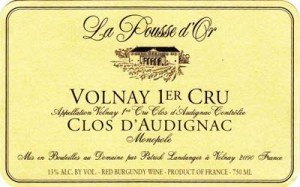
Volnay 1er Cru ‘Clos de la Bousse d’Or’ Monopole
This walled monopole vineyard is located next to the Volnay town hall. A quarter of vines was planted in 1958; the rest in the late 1960s and 1970s. Hand-harvested. Destemmed and fermented on indigenous yeasts in temperature controlled tanks. Aged in French barrique (30% new) for 15 months. Unfined and unfiltered.
- Download fact sheet (PDF)
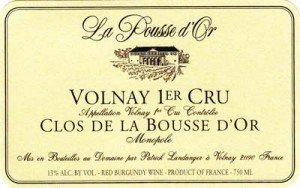
Volnay 1er Cru ‘Clos de la Bousse d’Or’ Monopole (Amphora-aged)
This special cuvee is sourced from the same monopole vineyard, yet was aged in terracotta amphorae for 15 months.
- Download fact sheet (PDF)

Volnay 1er Cru ‘Clos de 60 Ouvrees’ Monopole
An inner lieu-dit of ‘Caillerets,’ located on the border with Meursault, with soils rich in marl and limestone. Nearly half the vines was planted in the 1950s; the rest in the 1980s. Hand-harvested. Destemmed and fermented on indigenous yeasts in temperature controlled tanks. Aged in French barrique (30% new) for 15 months. Unfined and unfiltered.
- Download fact sheet (PDF)

Volnay 1er Cru ‘Clos de 60 Ouvrees’ Monopole (Amphora-aged)
A glorious example of the punch and power of ’60 Ouvrees,’ aged entirely in terracotta amphorae. Here any oaky influence is replaced with even more velvety textures, more expressive aromas; try these two wines side by side to see how a winemaker’s decisions in the cellar can certainly influence the character of the final wine.
- Download fact sheet (PDF)
Volnay 1er Cru ‘En Caillerets'
East-facing, ‘En Caillerets’ is ideally positioned; stony, rich in marl and limestone, the site’s high percentage of clay is also believed to contribute to the wine’s supple mouthfeel.
- Download fact sheet (PDF)

Gevrey-Chambertin 1er Cru ‘La Perrière'
A new addition to the estate’s Cotes de Nuits’ lineup, ‘Perrieres’ is a poised and perfect Pinot Noir, a vineyard located just downslope from the impeccable terroir of grand cru Mazis-Chambertin. Structure, brooding fruit, tons of freshness — it’s all here.
- Download fact sheet (PDF)

Chambolle-Musigny 1er Cru 'Charmes'
A gorgeous premier cru with a lacy texture and penetrating Pinot fruit aromas. ‘Charmes’ in its youth delivers bright red fruits (strawberries and pomegranate) yet with age, picks up more sensual, earthy tones.
- Download fact sheet (PDF)

Chambolle-Musigny 1er Cru 'Feusselottes'
The combination of this vineyard’s old-vine fruit and stony, mineral-rich terroir makes ‘Feusselottes’ not only a must-have but also an ideal wine for the cellar. A textbook Chambolle, marrying power and finesse.
- Download fact sheet (PDF)

Chambolle-Musigny 1er Cru 'Groseilles'
A delicious berry salad on the nose and palate (“groseilles” are currants; it’s uncanny how the wine’s aromas reflect the vineyard’s name!) and plenty of silky texture and supple fruit.
- Download fact sheet (PDF)
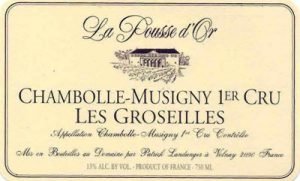
Chambolle-Musigny 1er Cru 'Amoureuses'
One of Chambolle’s more silky, subtle wines. Always rich and silky, with a characteristic mineral edge that comes from its pure limestone soils. It’s also a grand cru in disguise; ‘Amoureuses’ is neighbors with grand cru Musigny.
- Download fact sheet (PDF)

Charmes-Chambertin Grand Cru
Charmes leans into its name like no other grand cru — here fruit is afire with a rubied glow, each sip is electrically charged and firecracker-fresh, the finish soothes and swaddles and leaves a smile on your face. Pousse’s biodynamic care takes Charmes and puts it on a whole new, heavenly level.
- Download fact sheet (PDF)
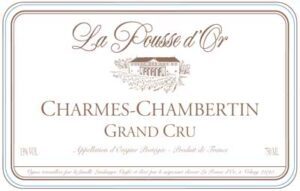
Echezeaux Grand Cru
A selection of fruit from the very heart of Echezeaux, this grand cru is stacked and packed and endlessly enchanting. Made for the long haul, but so captivating with its earthy perfumes, its stony persistence.
- Download fact sheet (PDF)

Corton-Bressandes Grand Cru
The estate’s single acre of vines was planted in 1956, 1986 and 1994, and faces east. Hand-harvested. Destemmed and fermented on indigenous yeasts in temperature controlled tanks. Aged in French barrique (30% new) for 18 months. Unfined and unfiltered.
- Download fact sheet (PDF)

Corton-Clos du Roi Grand Cru
An historic walled plot located above Corton-Bressandes, ‘Clos du Roi’ is full, broad and intense. Soils blend clay and limestone; vines were planted in 1979 and 1987. Hand-harvested. Destemmed and fermented on indigenous yeasts in temperature controlled tanks. Aged in French barrique (30% new) for 18 months. Unfined and unfiltered.
- Download fact sheet (PDF)

Clos de la Roche Grand Cru
Expressive, complex, uncompromising. One of the grandest grand cru Burgundies, and one that requires patience — stash this in a cool cellar and be astounded.
- Download fact sheet (PDF)
Bonnes Mares Grand Cru
Estate vines total just under one-half acre, planted on “terres rouges,” iron-rich clay and limestone, on the Chambolle side of this historic grand cru vineyard. The vineyard draws its name from ancient sculptures that were found at the site, a trio of goddesses or “good fairies.”
- Download fact sheet (PDF)
